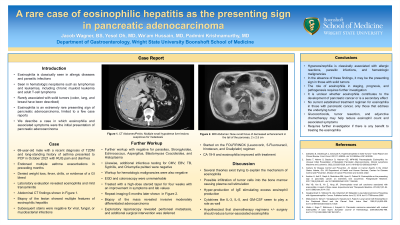Monday Poster Session
Category: Biliary/Pancreas
P1884 - A Rare Case of Eosinophilic Hepatitis as the Presenting Sign in Pancreatic Adenocarcinoma
Monday, October 28, 2024
10:30 AM - 4:00 PM ET
Location: Exhibit Hall E

Has Audio

Jacob Wagner, BS
Wright State University
Hudson, OH
Presenting Author(s)
Jacob Wagner, BS1, Yesol Oh, MD1, Omair Khan, MS2, We'am Hussain, MD3, Padmini Krishnamurthy, MD1
1Wright State University, Dayton, OH; 2Kansas City University, Dayton, OH; 3Wright State University Boonshoft School of Medicine, Dayton, OH
Introduction: Eosinophilia is a common finding seen in allergic diseases, parasitic infections, and hematologic malignancies including lymphomas, systemic mastocytosis, and certain leukemias.1,2 However, eosinophilia can be a rare presenting feature of solid tumors, specifically pancreatic malignancies. Here, we describe a case in which eosinophilia and its associated symptoms served as the initial presentation of pancreatic adenocarcinoma.
Case Description/Methods: A 69-year-old male with new onset type II diabetes mellitus and history of well-controlled asthma initially presented to his primary care physician with right upper quadrant abdominal pain and associated diarrhea. He denied any appetite changes or weight loss but had multiple recent asthma exacerbations requiring three courses of oral corticosteroids. Laboratory evaluation showed peripheral eosinophilia and mild transaminitis but was otherwise unremarkable. Subsequent CT imaging revealed multiple hypodense hepatic lesions that were consistent with eosinophilic hepatitis on biopsy. The patient underwent extensive workup, including tests for parasitic and fungal infections, hematologic malignancies, and evaluation for autoimmune and acquired hepatobiliary disorders, which were all negative. After months of follow-up, abdominal imaging was repeated and MRI of the abdomen revealed a new mass in the tail of the pancreas, with subsequent biopsy confirming invasive pancreatic adenocarcinoma (Figure 1). The patient was started on the FOLFIRINOX regimen with improvement in CA 19-9 and his eosinophilia.
Discussion: In rare cases, eosinophilia without evidence of an allergic reaction, parasitic infection, or hematologic malignancy may be the presenting sign in those with solid tumors. Its role in the staging, prognosis, and pathogenesis requires further investigation. It is unclear whether eosinophilia contributes to the development of pancreatic cancer or is a secondary effect. Therefore, it may be beneficial to conduct further investigation for pancreatic malignancy in patients presenting with abdominal symptoms and unexplained eosinophilia.
1. Zalewska E, Obołończyk Ł, Sworczak K. Hypereosinophilia in Solid Tumors: Case Report and Clinical Review. Front Oncol. 2021;11:639395. doi:10.3389/fonc.2021.639395
2. Badra T, Nehme S, Baydoun O, Hachem GE. MPN-092 Paraneoplastic Eosinophilia: An Unusual Initial Presentation of Metastatic Pancreatic Adenocarcinoma. Clinical Lymphoma Myeloma and Leukemia. 2022;22:S325-S326. doi:10.1016/S2152-2650(22)01436-7

Disclosures:
Jacob Wagner, BS1, Yesol Oh, MD1, Omair Khan, MS2, We'am Hussain, MD3, Padmini Krishnamurthy, MD1. P1884 - A Rare Case of Eosinophilic Hepatitis as the Presenting Sign in Pancreatic Adenocarcinoma, ACG 2024 Annual Scientific Meeting Abstracts. Philadelphia, PA: American College of Gastroenterology.
1Wright State University, Dayton, OH; 2Kansas City University, Dayton, OH; 3Wright State University Boonshoft School of Medicine, Dayton, OH
Introduction: Eosinophilia is a common finding seen in allergic diseases, parasitic infections, and hematologic malignancies including lymphomas, systemic mastocytosis, and certain leukemias.1,2 However, eosinophilia can be a rare presenting feature of solid tumors, specifically pancreatic malignancies. Here, we describe a case in which eosinophilia and its associated symptoms served as the initial presentation of pancreatic adenocarcinoma.
Case Description/Methods: A 69-year-old male with new onset type II diabetes mellitus and history of well-controlled asthma initially presented to his primary care physician with right upper quadrant abdominal pain and associated diarrhea. He denied any appetite changes or weight loss but had multiple recent asthma exacerbations requiring three courses of oral corticosteroids. Laboratory evaluation showed peripheral eosinophilia and mild transaminitis but was otherwise unremarkable. Subsequent CT imaging revealed multiple hypodense hepatic lesions that were consistent with eosinophilic hepatitis on biopsy. The patient underwent extensive workup, including tests for parasitic and fungal infections, hematologic malignancies, and evaluation for autoimmune and acquired hepatobiliary disorders, which were all negative. After months of follow-up, abdominal imaging was repeated and MRI of the abdomen revealed a new mass in the tail of the pancreas, with subsequent biopsy confirming invasive pancreatic adenocarcinoma (Figure 1). The patient was started on the FOLFIRINOX regimen with improvement in CA 19-9 and his eosinophilia.
Discussion: In rare cases, eosinophilia without evidence of an allergic reaction, parasitic infection, or hematologic malignancy may be the presenting sign in those with solid tumors. Its role in the staging, prognosis, and pathogenesis requires further investigation. It is unclear whether eosinophilia contributes to the development of pancreatic cancer or is a secondary effect. Therefore, it may be beneficial to conduct further investigation for pancreatic malignancy in patients presenting with abdominal symptoms and unexplained eosinophilia.
1. Zalewska E, Obołończyk Ł, Sworczak K. Hypereosinophilia in Solid Tumors: Case Report and Clinical Review. Front Oncol. 2021;11:639395. doi:10.3389/fonc.2021.639395
2. Badra T, Nehme S, Baydoun O, Hachem GE. MPN-092 Paraneoplastic Eosinophilia: An Unusual Initial Presentation of Metastatic Pancreatic Adenocarcinoma. Clinical Lymphoma Myeloma and Leukemia. 2022;22:S325-S326. doi:10.1016/S2152-2650(22)01436-7

Figure: Figure 1. MRI abdomen with and without contrast: New ovoid focus of decreased enhancement in the tail of the pancreas measuring 2 x 2.5 cm, concerning for a possible neoplastic mass
Disclosures:
Jacob Wagner indicated no relevant financial relationships.
Yesol Oh indicated no relevant financial relationships.
Omair Khan indicated no relevant financial relationships.
We'am Hussain indicated no relevant financial relationships.
Padmini Krishnamurthy indicated no relevant financial relationships.
Jacob Wagner, BS1, Yesol Oh, MD1, Omair Khan, MS2, We'am Hussain, MD3, Padmini Krishnamurthy, MD1. P1884 - A Rare Case of Eosinophilic Hepatitis as the Presenting Sign in Pancreatic Adenocarcinoma, ACG 2024 Annual Scientific Meeting Abstracts. Philadelphia, PA: American College of Gastroenterology.
